
| Photos From Wyoming Tales and Trails This page: Newcastle, Tubb Town, the Coming of the Railroad. |
 |

| Photos From Wyoming Tales and Trails This page: Newcastle, Tubb Town, the Coming of the Railroad. |
 |
|
|
|
About This Site |
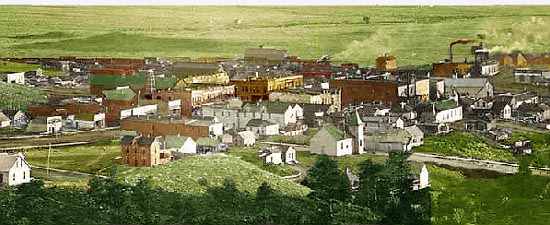 Newcastle, 1905 In the 1880's, the Chicago, Burlington and Quincy Railroad continued its expansion with a western push across Nebraksa and into Dakota. By 1882 the line had been extended to Alliance, Nebraska. With the discovery of coal at Cambria, Wyoming, mining equipment had to be hauled westward by freighter from the railhead at Alliance. By 1889, the railroad had reached Edgemont, Dakota Territory. From there extensions pushed westward into Wyoming and northward to Deadwood. The extension into Wyoming ultimately became the mainline when in 1894 it reached Billings, Montana, and provided connections to the Pacific Coast via the Northern Pacific and the Great Northern lines.
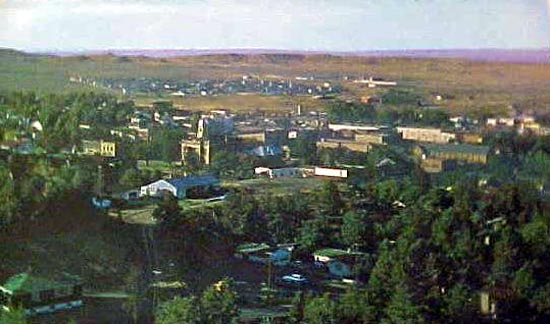 Newcastle, approx. 1955 The building in the center of the photograph is the Weston County Courthouse constructed in 1910-11. Although, the Black Hills were reputedly the first area of Wyoming to be explored, it was also the last. Joseph and Francois Verendrye, French-Canadians, explored portions of Montana and Northeastern Wyoming as early as 1743. But because of Inidan threats, the area remained essentially unexplored until the Custer expedition of 1874. Until the coming of the railroad, the area of present-day Weston County was populated only by a few road agents who infested Whoop-Up Canyon along the line of the Cheyenne and Black Hills Express line and even fewer trappers and stockmen. The first place reached by the railroad was Newcastle in August 1889.
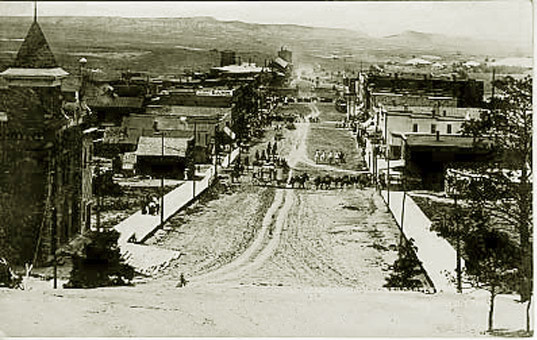 Newcastle, undated. The building on the left is the Town Hall constructed at a cost of $6,000.00. Newcastle was established by Joseph H. Hemingway, superintendent of the Cambria Coal Company, and was named by him after his hometown in England. The coal, itself, had been discovered by Frank Wheeler Mondell (1860-1939) who arrived in the area in 1887. Mondell had been orphaned at age 7 and reared by a minister in Dickinson County, Iowa. Mondell, his wife, Ida Harris Mondell, and Elbert Mondell began acquiring coal and mining lands in Weston and Crook Counties. The first lots in Newcastle were sold on Sept. 10, 1889. The same day all of the inhabitants and businesses of Tubb Town, located on Salt Creek and the Custer-Belle Fourche Trail, picked up lock, stock and whiskey barrel and moved to Newcastle. One saloon owner loaded the bar on the back of a wagon and continued to serve his thirsty patrons on the trek. Prior to the move, Tubb Town had earned a reputation as being a bit lively. A month before the move, the Sundance Gazette reported: That always lively place, Tubtown, was the scene of unusually stirring times Saturday last. At one time a number of fights were going on in the street, and Deputy Swisher was worn out trying to stop them. No sooner would he quell one of the melees than he would see another fightgoing on a little ways off. He finally quit in disqust, and told the boys to fight all they wanted, but he would kill the first one who tried to use a gun. The trouble was caused by a fistic rivalry between graders and miners, large numbers of whom were in town that day. From all accounts an officer in a town like tibville couldn't be paid all he earns, as a good many frequenters there want to deal out misery to him in big chunks.Tubb Town, two miles northeast of Newcastle, had been established a year before by Delos Dewitt Tubbs (1849-1930) in anticipation of the Railroad coming. Tubbs apparently overlooked that the railroad was also in the real estate business and that all the towns along its tracks were laid out by its subsidiary, the Lincoln Land Company. Tubbs was the brother of Custer City, Dakota Territory, sheep mogul, Newton S.Tubbs. The inhabitants of another town, Whoop-up, established a year before Tubb Town, had all moved to Tubb Town for the expected prosperity. The precise location of Whoop-up is apparently unknown. In 1899, the MW Cattle Company constructed a reservoir on Whoop-Up Creek. A year later, the dam failed. Thus, there is the possibility that the townsite of Whoop-up was either destroyed by the impoundment of the reservoir or by the subsequent flood. Unfortuantely for the residents of Tubb Town, the Railroad went to Newcastle instead. Tubbs returned to Custer City.
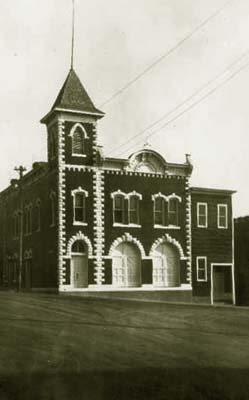 . . . . . .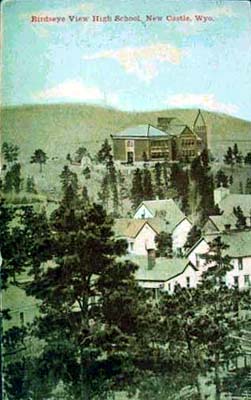
Left, Town Hall; Right, School
 Antlers Hotel, 1939 During the Indian scare of 1890, see Wounded Knee, the building was fortified and stocked with guns and ammunition. The windows were barracaded with sacks of flour. A ladder was constructed so as to provide access to the roof from which the defenders could fire upon the Indians' expected attack.
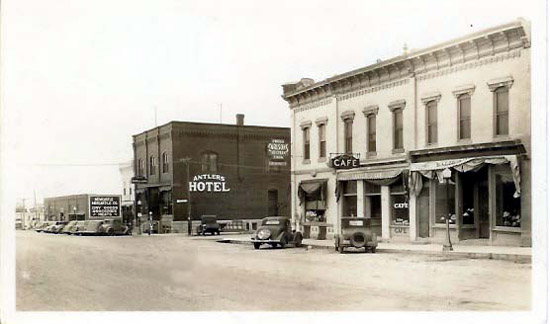 Antlers Hotel, 1939 Note: From the cars parked in front of the hotel, the above two postcards were taken at the same time. The Antlers Hotel was at one time owned by one of those who moved to Newcastle from Tubb Town on the first day, Peter J. Kinney (1861-1927). Kinney, in addition to owing the Antlers also owned the Park Hotel, founded the City's electric system, and served as Mayor. After the above photos were taken the hotel was modernized. In 2009, the hotel was again rennovated and restored to its old elegance when it had served as the "home away from home" for oil producers in Weston County.
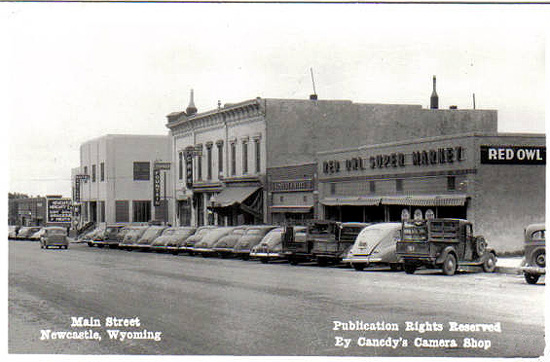 Antlers Hotel, 1940's Next Page: Newcastle continued |